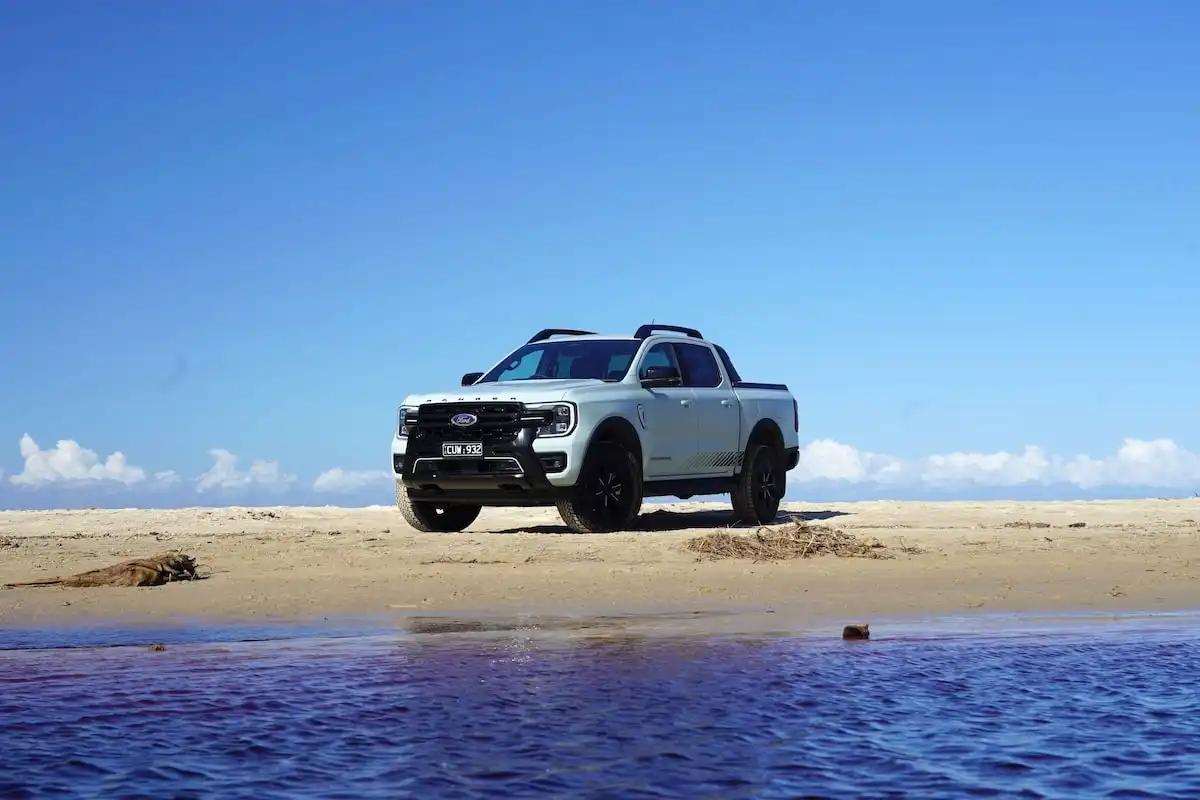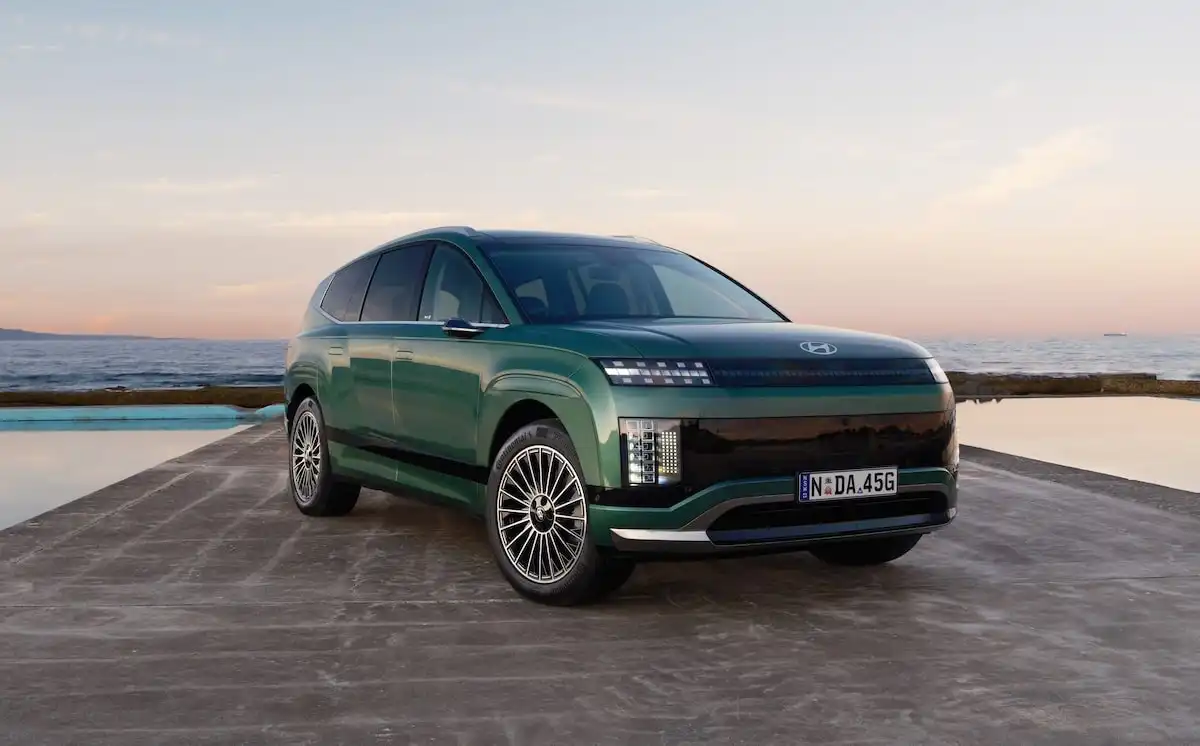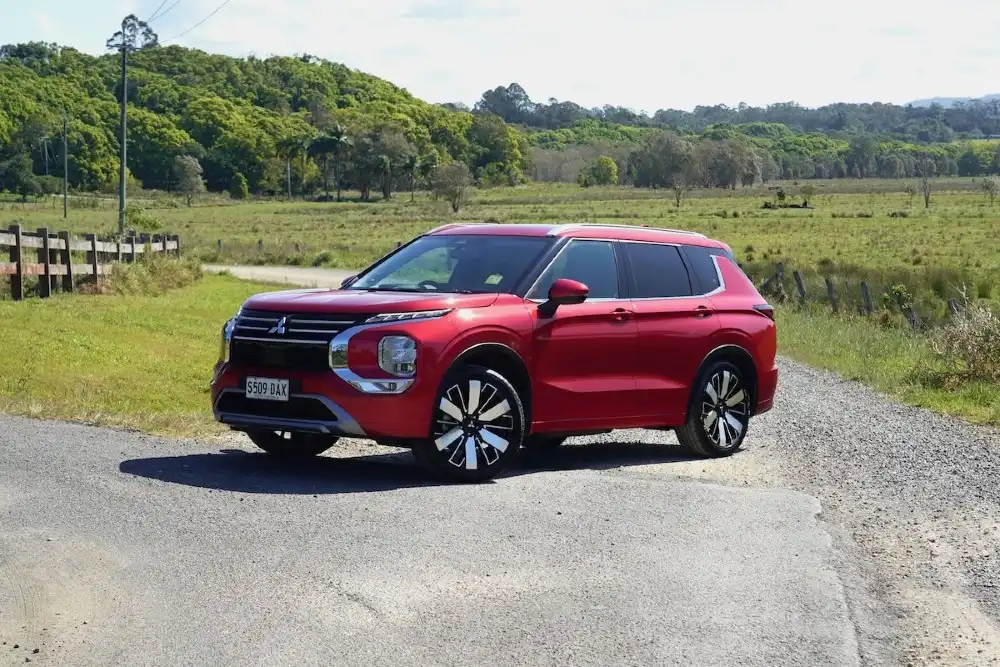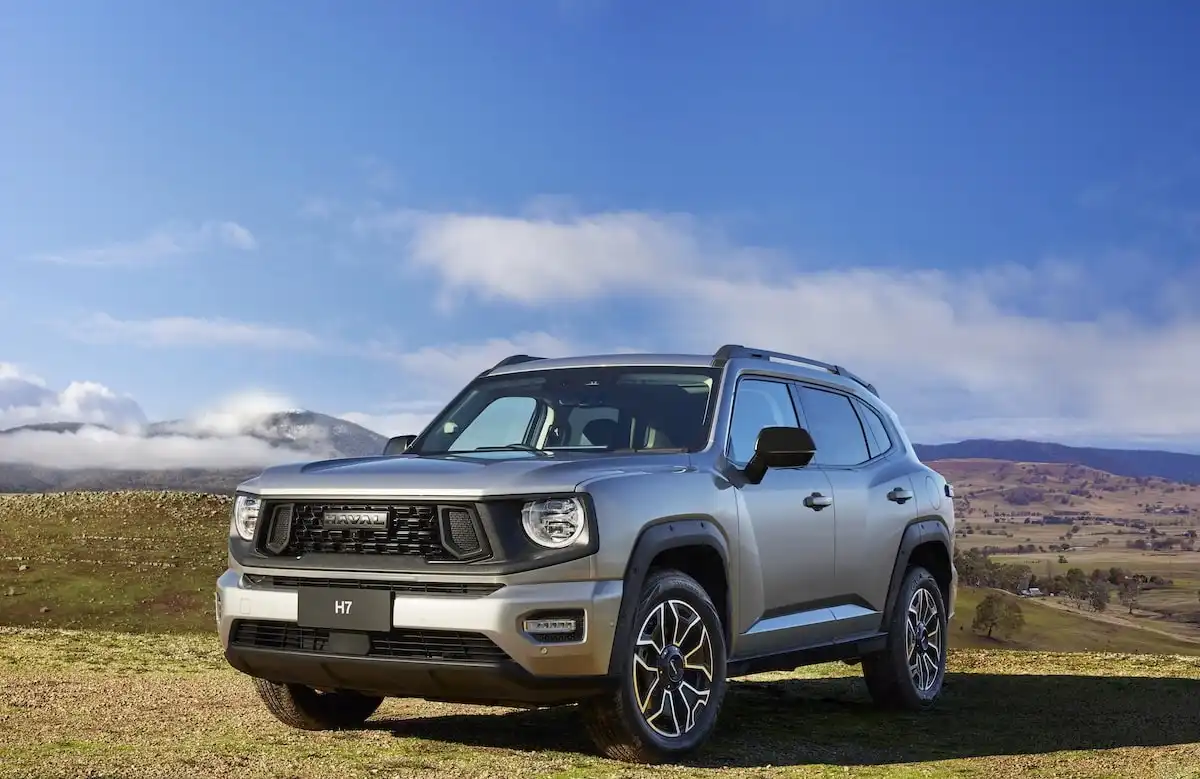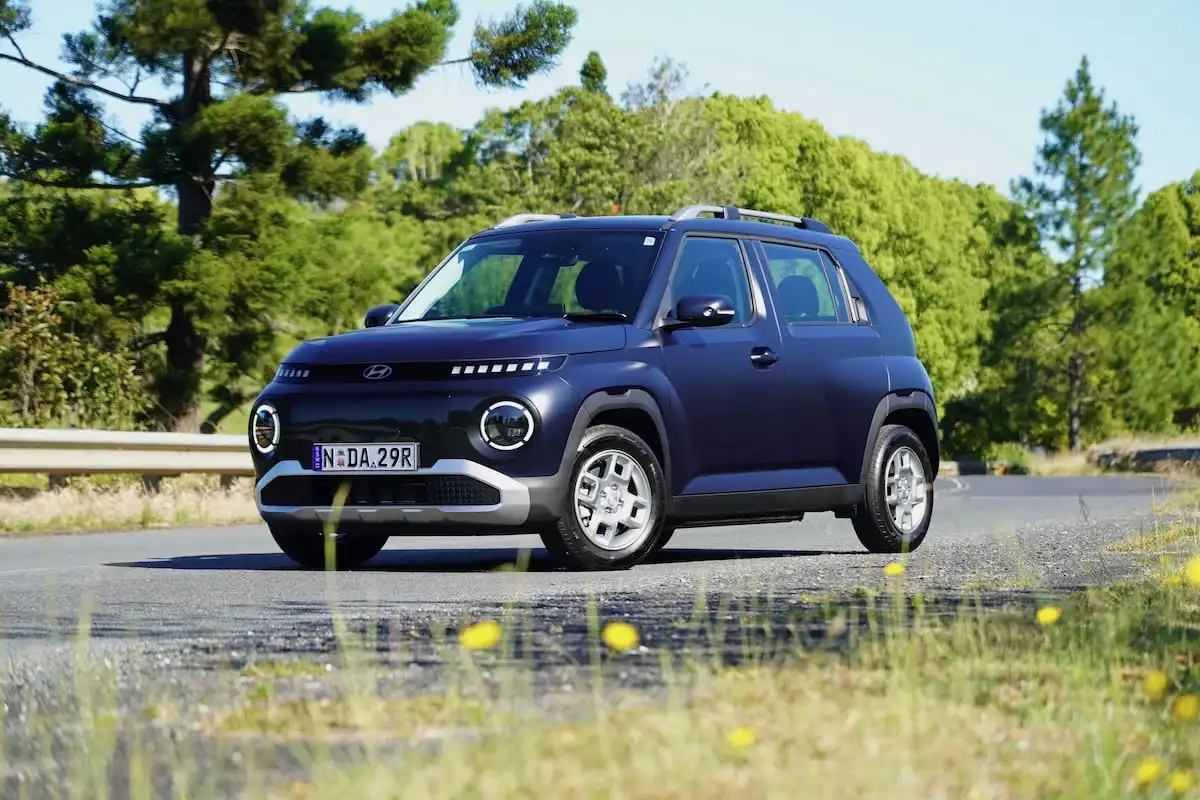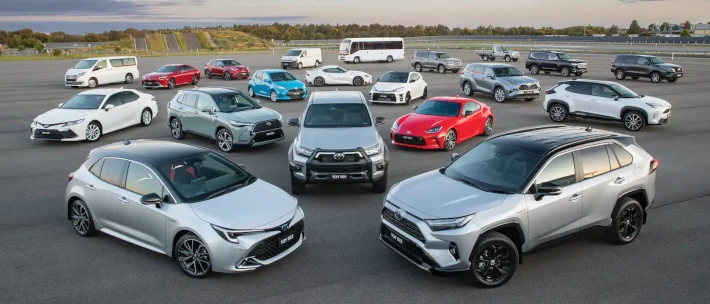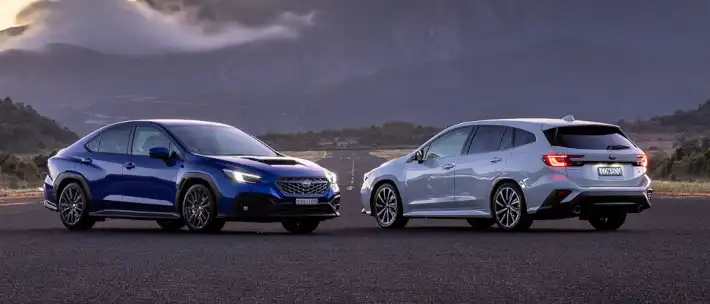The Ford Ranger PHEV Stormtrak is one of the first examples of a market segment on the cusp of a boom.
Following in the footsteps of the BYD Shark 6 and the GWM Cannon Alpha, Ford's take on the plug-in hybrid recipe comes packaged into arguably the most popular dual-cab ute on the market.
The utility pitch pairs the Ranger’s go-anywhere platform with a sizable onboard battery, allowing for EV-only driving, improved fuel efficiency and even the ability to power your campsite or tools or you're out on the road.
Just how well does Ford's first attempt at a plug-in hybrid version of the almighty Ranger stack up against the existing competitors- and does it command attention over the regular Ranger lineup?
We got behind the wheel of the Stormtrak variant to find out.

Ford Ranger PHEV Stormtrak Competition
Ford Ranger PHEV Stormtrak |
VS |
BYD Shark 6 |
| GWM Cannon Alpha PHEV | ||
| Volkswagen Amarok | ||
| Toyota HiLux | ||
| Mitsubishi Triton |
How Much Does It Cost?
Ford offers the plug-in hybrid version of the Ranger in four different flavours, with this Stormtrak version sitting at the top of the range.
Prices kick off from $71,990 for the entry-level Ranger PHEV XLT and stretch out to $86,990 for this flagship Stormtrak variant before on-road costs are applied.
-
Ranger PHEV XLT - $71,990
-
Ranger PHEV Sport - $75,990
-
Ranger PHEV Wildtrak - $79,990
-
Ranger PHEV Stormtrak - $86,990 (tested)
Prices are subject to change and do not include on-road costs.

How Much Can OnlineAuto Save You?
Using OnlineAuto's car buying service, you could save thousands on your next car with the help of our team of car-buying specialists.
Ford Ranger PHEV Stormtrak Specifications
| Model Date | 2025 |
| Make | FORD |
| Model | RANGER |
| Series | PY MY25.75 |
| Variant | PHEV STORMTRAK (4x4) |
| Body | DOUBLE CAB P/UP |
| Fuel type | PREMIUM UNLEADED/ELECTRIC |
| Transmission | 10 SP AUTOMATIC |
| Drive | 4x4 |
| Engine | TMPFI |
| Engine capacity | 2261 |
| Engine configuration | DUAL OVERHEAD CAM / 16 valves |
| Engine RPM | 4600.0 / 2700.0 |
| Cylinders | T4 |
| Torque | - |
| KW | 138 |
| Fuel tank size | 70.0 |
| Fuel usage specs | 2.7 / 0 |
| CO2 | 66 |
| ANCAP security rating | Unrated |
Get in touch with one of our Car Buying Specialists today.
Request a quoteWhat Features Does the Ford Ranger PHEV Stormtrak Have?
Features reserved for the Stormtrak variant include a set of bespoke 18-inch alloys with grey accents wrapped in all-terrain tyres, a unique front grille design, Stormtrak decals, a gloss black rear bumper, Ford's flexible rack sports bar, Stormtrak lettering on the leather upholstered front seats, a cargo management system and six auxiliary power switches.
You also pick up features found in the Wildtrak PHEV, which bundles in adaptive Matrix LED headlights, roof rails, a powered tonneau cover, ambient lighting, leather upholstery, a surround-view monitor and Ford's Pro Trailer back-up assist.
The features list builds upon everything bundled into the Sport PHEV, which receives LED running lamps and fog lights, eight-way power-adjustment for the front seats with seat heating, a wireless charging pad, pop-up cupholders, rear privacy glass and a pair of front-mounted tow hooks.
Of course, there's all the equipment found in the entry-level Ranger PHEV XLT, including the full-time four-wheel drive system with a low-range transfer case and locking rear differential, LED tail lights, side steps, an 8.0-inch digital instrument cluster, front & rear parking sensors, keyless entry & start, adaptive cruise control, steel underbody protection and front and rear disc brakes.
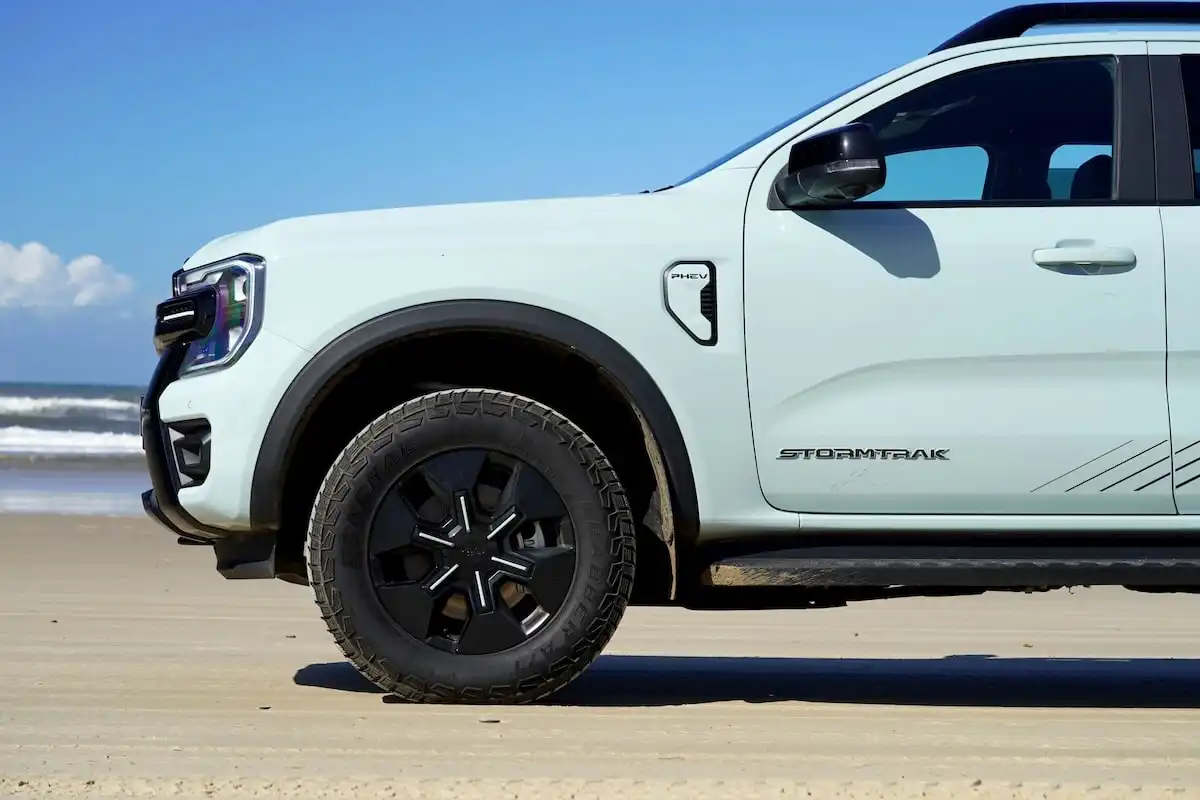
Ford Ranger PHEV Connectivity & Infotainment Features
Buyers on a budget will be happy to hear that all versions of the Ranger PHEV lineup come equipped with the same technology offering.
That means there's a 12-inch touchscreen infotainment display nestled into the dashboard of the XLT base model, all the way through to this Stormtrak flagship.
Ford's display is a solid offering, ticking the all-important boxes of screen size, resolution, responsiveness and brightness levels.
The vertical arrangement looks tidy, while Ford's layout remains user-friendly to operate thanks to a permanent set of shortcuts at the base of the display.
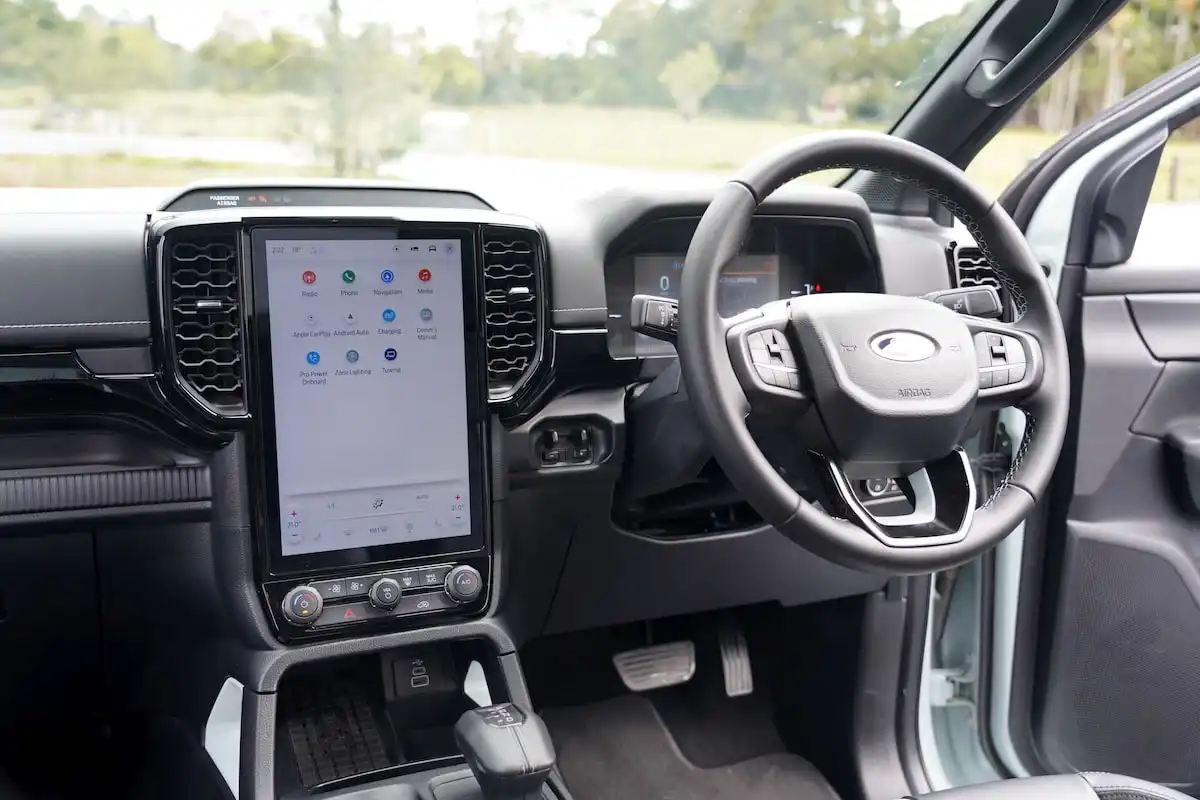
While not quite as feature-rich as its Chinese rivals, Ford's 12-inch portrait display remains competitive in the segment and offers a welcome range of off-road-focused menus and live camera views to help out when conquering tough terrain.
There's AM/FM and DAB+ digital radio packaged in as standard, with the entry-level XLT picking up a six-speaker sound system, which leaves a fair bit to be desired in terms of power.
Upgrading to the PHEV Wildtrak or Stormtrak variants adds a much more respectable ten-speaker sound system courtesy of B&O.
Does the Ford Ranger PHEV Have Wireless Apple CarPlay & Android Auto?
Yep, it sure does.
Ford's 12-inch infotainment system offers both wired and wireless smartphone mirroring for iOS and Android devices.
This means you can climb aboard with your phone in your pocket while accessing your preferred navigation app, music and podcasts with the help of wireless Apple CarPlay or Android Auto, or while charging your phone via the wireless charging pad.
You can also connect your phone via one of the USB-C ports in the front of the cabin.

Our experience pairing an iPhone with Ford’s infotainment system was seamless, with no drop-outs in the connection nor issues when pairing and handing over the primary connection with a co-pilot's iPhone.
What Engine Powers the Ford Ranger PHEV?
The Ranger PHEV lineup comes powered by a 2.3-litre turbocharged four-cylinder petrol paired with an electric motor.
It’s actually the same four-pot you'll find powering the Mustang Ecoboost range, with outputs standing at 138kW of power and 411Nm of torque on its own steam.
The petrol engine is paired with an electric motor that lifts the Ranger PHEV's combined outputs to 207kW of power and a very handy 697Nm of torque.
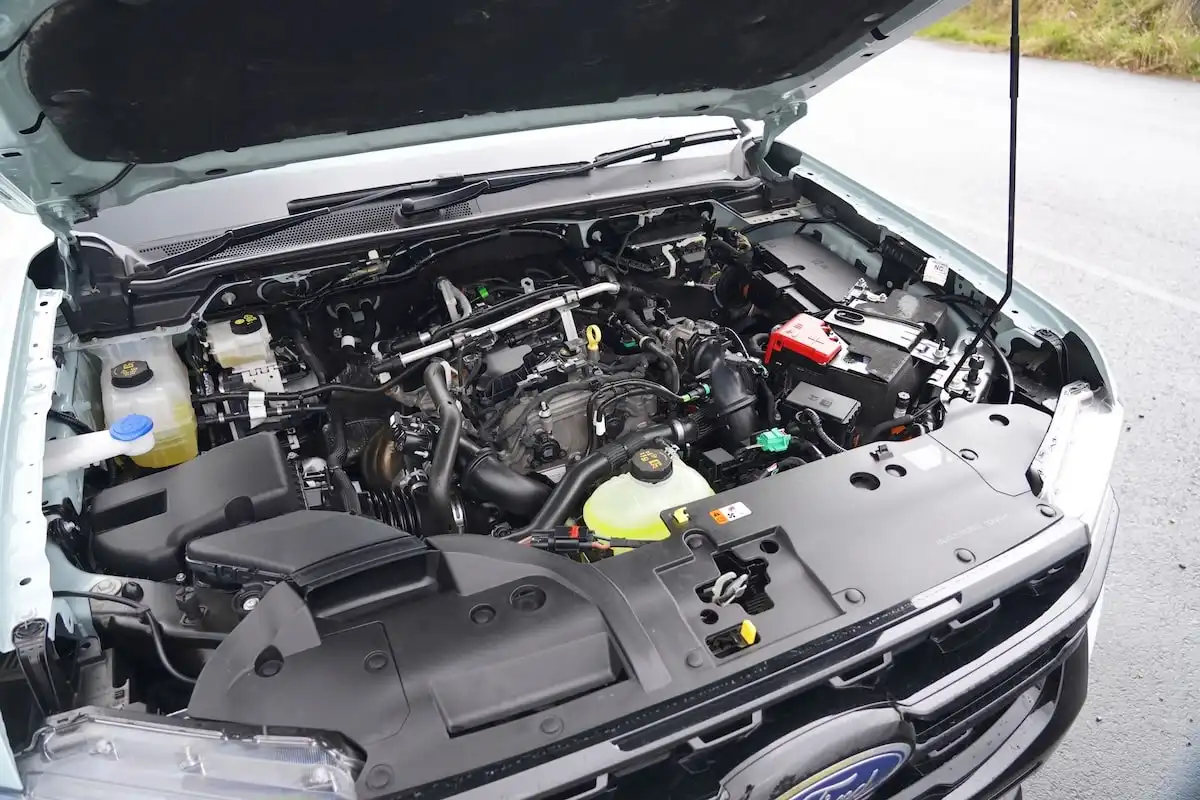
This gives the Ranger PHEV more torque than the performance flagship Raptor variant, though it's down on power.
The Ranger PHEV can power all four wheels permanently via the ten-speed hybrid transmission, including on the highway in 4WD automatic mode, with 2H, 4H and 4WD low-range also on the menu.
How Far Can You Drive the Ford Ranger PHEV in EV Mode?
The Ranger PHEV is outpaced by its Chinese rivals when it comes to outright battery capacity.
Ford has packaged the Ranger with an 11.8kWh battery pack, which the company says offers up to 49km worth of range on the very lenient NEDC test cycle.
That puts it down considerably on the BYD Shark’s 29.58kWh worth of battery capacity and well below that of the GWM Cannon Alpha's massive 37.1kWh battery, which each offer a claimed 80 and 115km worth of EV range, respectively.

The trade-off here, though, is that the Ranger PHEV's smaller battery means it trumps the Cannon and Shark 6 on payload figures- making it a more work-oriented package overall.
In a test of the EV-Now mode, we managed to hit the 35-kilometre mark before running out of charge on a mix of stop-start traffic in town and a brief stint at highway speeds.
-
Battery Size: 11.8kWh
-
Energy Efficiency: 18.7kWh per 100km (claimed)
-
EV Range: 49km (claimed)
-
EV Range: 35km (tested)
Is the Ford Ranger PHEV Stormtrak Comfortable to Drive?
It absolutely is - perhaps more so than the regular Ranger platform due to the added mass over the rear axle.
One of the primary criticisms of utes, is that the work-focused, cargo-carrying design and requisite hardware result in a few compromises to ride quality, particularly on rougher roads.
In the Ranger PHEV, however, there's a few hundred kilograms extra tying down the rear axle, with Ford reworking the rear leaf-sprung suspension to accommodate the added mass.
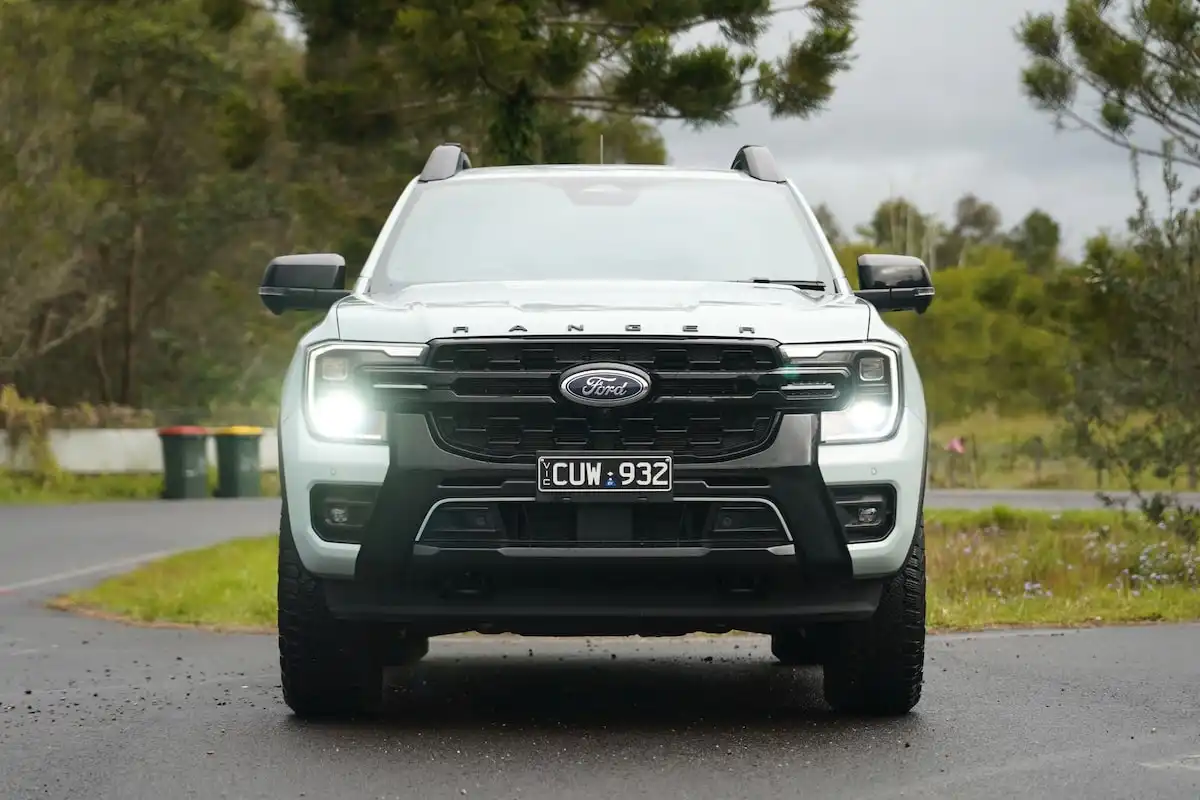
Considering the Ranger was already one of the most impressive utes on the market when it comes to the ride quality, this makes the PHEV Stormtrak a particularly sweet cruiser.
In terms of power, the Ranger PHEV offers great acceleration off the mark - when the battery is charged - thanks to that immediate injection of the e-motor's torque into the equation.
The package feels a little undergunned when the battery is depleted and the petrol engine has to do the heavy lifting, though it's not sluggish, while the transition between EV and petrol power delivery is nice and smooth.
Ford has four drive modes for the hybrid system with 'EV Now' sticking with electric power delivery alone, 'EV Auto' running a mix of both, 'EV' later preserving charge for down the road and 'EV Charge' running the petrol engine to add as much charge as possible to the battery.
There's a regenerative braking system to help feed the battery pack some extra juice otherwise lost during braking while the steering is nicely weighted for more mundane driving around town.
You certainly need to keep an eye on the haunches around town or while tackling a tight car park, though overall, the Ford Ranger PHEV retains all the user-friendly hallmarks that have made the latest-gen Ranger lineup a hit with Aussie buyers.
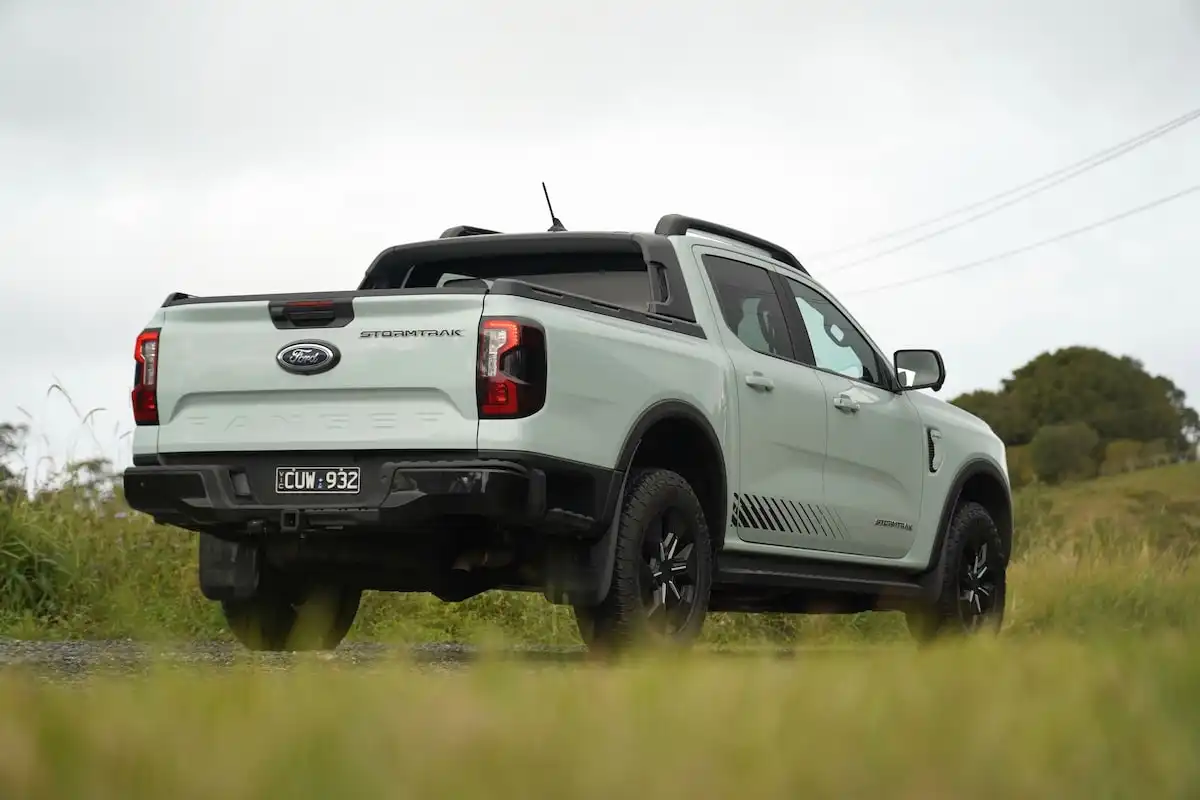
Pick up the pace on a country road and things feel super solid and confidence-inspiring on a bumpy surface that speaks volumes about the Ranger platform as a whole, even with the added mass.
The ride is also reasonably quiet, even with the aggressive all-terrain tyres fitted, which makes the Ranger PHEV a very well-mannered long-distance highway cruiser.
All up, we think Ford has done a bang-up job with the plug-in hybrid version of the Ranger, effectively giving it a heart transplant without losing any of its DNA on a mix of town and country driving.
Is it a Good Off-Roader?
The Ranger PHEV is, without a doubt, the most capable off-roader in the plug-in hybrid ute segment.
By the feel of things, Ford has ensured the process of transforming the Ranger platform into a more fuel-efficient PHEV package has come with no major compromises to the off-road driving experience.
The Ranger's excellent ground clearance figures, extremely competent four-wheel drive system, clever drive and traction control modes and a locking rear differential allow it to conquer virtually anything you throw at it.
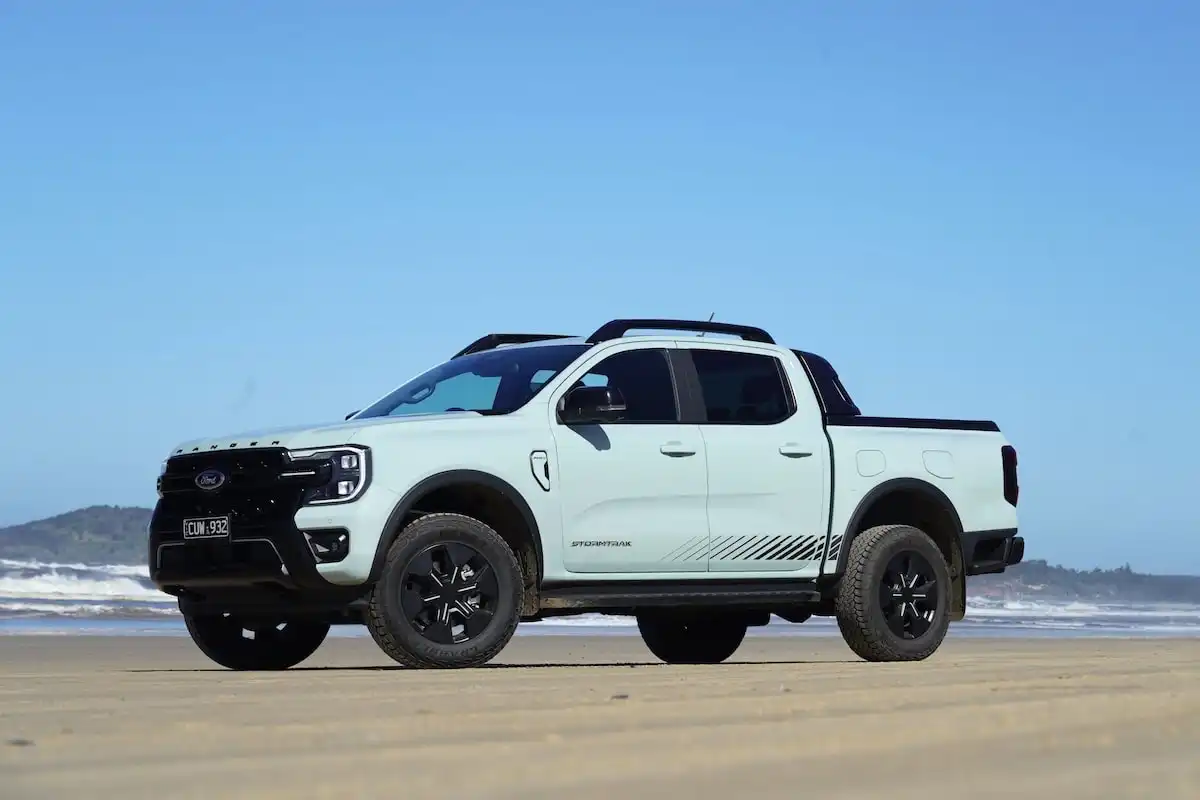
Better yet, the 18-inch alloys are wrapped in a pretty aggressive set of General Tire A/T Sport W tyres that offer tonnes of traction in the loose stuff, while acres of real estate in the wheel arches provide stacks of suspension travel and wheel articulation over large obstacles.
Ford has also positioned the battery pack well within the platform, meaning it's not quite as compromised as the GWM Cannon Alpha, which has its pack effectively hanging out at the rear.
There is added mass to contend with, for sure, though the added torque from the electric motor offers a nice way to tackle the extra weight, while the ability to drive in 4H in EV mode is a very unique offering.
-
Ground Clearance: 226mm
-
Wading Depth: 800mm
-
Approach Angle: 30.2 degrees
-
Departure Angle: 24.2 degrees
-
Breakover Angle: 20.4 degrees
Is the Ford Ranger PHEV Fuel Efficient?
The Ford Ranger PHEV is reasonably fuel efficient, so long as you keep its battery pack topped up at home.
As we’ve already mentioned, the Ranger PHEV falls short of its Chinese rivals is outright battery capacity, which means your EV range takes a hit and you'll need to charge it more often than its main competitors if you want the best efficiency figures.
If you're vigilant about charging the battery to provide as much electrical assistance to the petrol engine, Ford says you can expect to sip as little as 2.9L per 100km on a combined cycle.
In reality, however, we saw figures closer to the 4.5 - 5L/100km mark with the battery charged up, increasing once again to north of the 8L per 100km mark when the battery is depleted and you're running around with minimal electrical assistance.
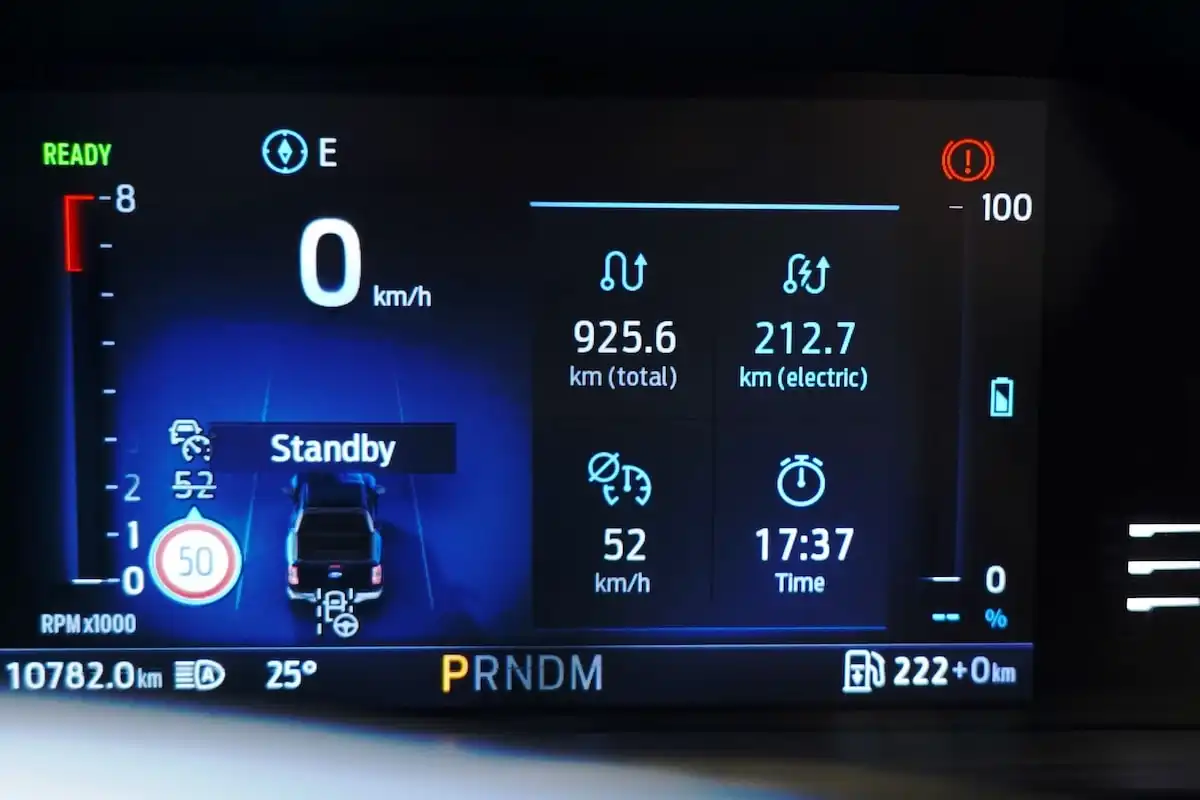
There's a 70-litre fuel tank fitted and, thankfully, the Ranger PHEV can be filled with 91 RON fuel.
For those wondering, unfortunately, the Ranger PHEV's battery pack does not support DC fast charging, though it can be AC charged at speeds up to 3.5kW, which brings the 11.8kWh NMC battery from 0 - 100 per cent in a claimed four hours.
How Much Can you Carry & Tow in the Ford Ranger PHEV Stormtrak?
As mentioned, the Ranger's comparatively smaller battery pack means that it offers buyers the current best-in-class payload figures for a plug-in hybrid electric dual-cab ute package.
Payload figures stand at 805kg in the Stormtrak, which edges out the Shark 6’s 790kg worth of payload and wipes the floor with the Cannon Alpha's 685 payload figures.
If you're looking for even more payload potential, the Ranger PHEV XLT offers up to 830kg worth of payload, dropping to 805kg in the PHEV Sport.

The Stormtrak's added weight from the PHEV system does, however, make it a bit less suited to the task of towing, which is something to keep in mind if pulling power is atop your wishlist.
Load it up with a 3.5 tonne trailer and subtract the Stormtrak’s 2,695kg kerb weight from the equation, and you're left with just 385kg from the 6,580kg GCM figures for people, belongings and any accessories you want to add.
-
Kerb Weight: 2,695kg
-
Braked Towing Capacity: 3,500kg
-
Gross Vehicle Mass: 3,500kg
-
Payload: 805kg
-
Gross Combination Mass: 6,580kg
Is it Practical and Spacious?
Climb aboard and you’ll see things are very familiar inside the Stormtrak's cabin.
This is a good thing, considering the Ranger's interior layout and practicality chops are amongst some of the best in the segment.
With the help of side steps and a grab handle at the A-pillar, hopping inside the cabin is reasonably simple, while the eight-way power-adjustable front seats can be raised considerably for a better view over the tall dashboard.

The amount of headroom is excellent for even the tallest of front occupants, while the amount of forward, side and rear visibility are all solid thanks to the lofty roofline design.
On the design front, the Stormtrak picks up some grey contrasts on the door sills and base of the centre console, while the leather-upholstered seats get contrast stitching, a vertical grey strip and embroidered 'Stormtrak' logos on the seats.
The leather-wrapped steering wheel feels nice and chunky, while there's a welcome soft-touch finish for your elbows on the centre armrest and the door sills, though your knees might bang up against some hard plastics on the door or centre console.
Ford’s cabin layout is incredibly user-friendly and will be welcomed by some buyers who aren't fans of the touchscreen-heavy controls found in its direct PHEV rivals.
There's physical media and climate control dials at the base of the screen, for example, as well as physical controls for the drive modes and 4x4 controls.
The cabin fit and finish is very solid, with no amount of jittery country roads able to extract a single squeak or rattle from the cabin.
We will say, however, that we’re not a massive fan of the mass of cheap-looking black plastics that stretch across the centre console, though it’s a better finish than the easily-scratched piano black you'll find in some rivals (cough, cough- HiLux).
In terms of storage, the Ranger PHEV is a strong contender.
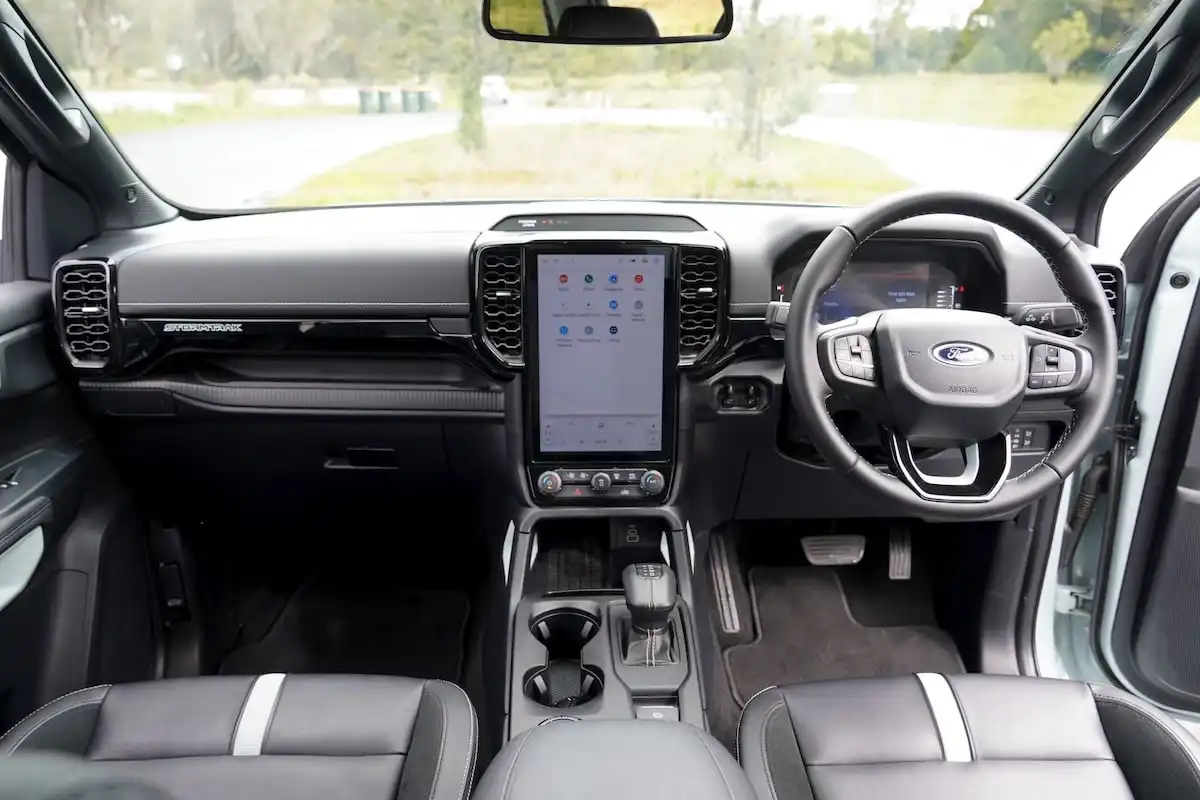
There's a wireless charging pad and a small tray housing two USB ports at the base hiding at the base of the dashboard, as well as a narrow little storage tray and a pair of cupholders flanking the transmission lever.
Further back, you've got access to a chunky storage box inside the folding armrest which features a neat little cut-out for your key and a 12-volt power outlet and decent-sized bottle holders in the door sills.
The passenger picks up two gloveboxes as well as a rubber-lined tray in the cut-out between the two, with a pair of pop-out cupholders sitting at either end of the dashboard.
All up, extremely solid marks in the front of the Ranger's cabin when it comes to passenger space and practicality.

Move to the rear and things aren't quite as spacious, though the Ranger holds its own for the dual-cab segment which is, ultimately, a bit compromised when it comes to the rear seat experience.
Behind my 185cm driving position, adults will find their knees brushing up against the seatback, though at least Ford's seats feature a clever little cut-out in the centre that makes use of limited space.
The elevated second row seats also mean that headroom is a bit tighter in the rear, though not to a significant degree, while the rear windows are nice and large, which adds a nice dose of light in the cabin.
Cabin width is pretty restrictive for three-abreast seating while a chunky transmission tunnel does eat away at some foot room, though it's a very kid-friendly offering back here.
Amenities in the rear include a set of air vents, a USB-C and USB-A charging port, map pockets, a folding armrest with two cup holders and average-sized bottle holders.
You’ll also find a 10-amp power outlet back here capable of pushing out a claimed 2.3kW worth of juice to keep bigger devices charged or power a blender if you're making mocktails out on the road.
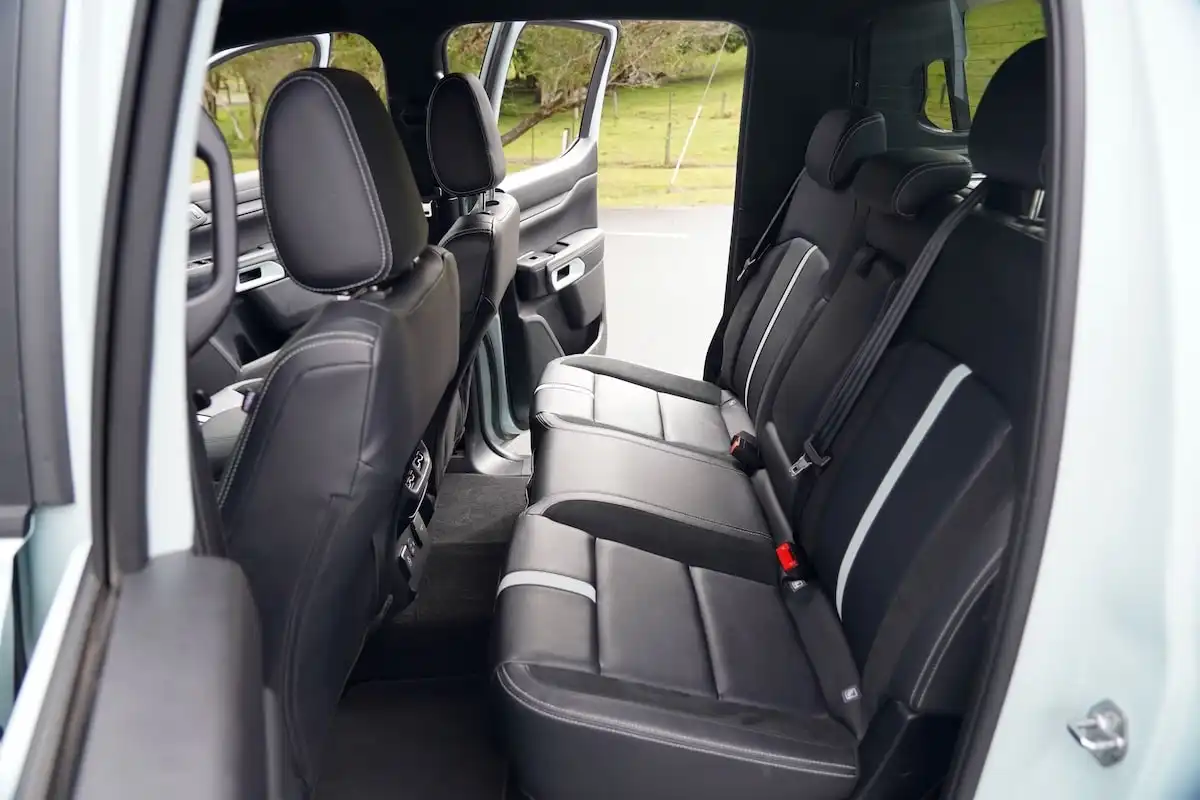
For the parents out there, the Ranger is equipped with ISOFIX anchors on each of the outboard seats as well as three top tether mounts hiding behind the seatbacks.
Compared to its direct plug-in hybrid rivals, there’s not quite as much space inside the Ranger as the Shark 6 and nowhere near as much as the GWM Cannon Alpha, but they're both longer wheelbase platforms, especially in the case of the Cannon Alpha.
When compared to the usual suspects within the dual-cab segment, however, the Ranger's cabin stands strong and remains a pretty family-friendly affair.
How Big is the Ford Ranger PHEV's Tray?
The Ford Ranger PHEV’s tray is actually slightly longer than the regular Ranger's tub.
That said, it's slightly shallower than the regular tub, due to the battery pack and some added hardware lurking beneath.
In total, the Ranger PHEV's tub measures 1,638mm long at the base, 1,584mm wide with 1,233mm of real estate between the wheel arches and stands 498mm tall.
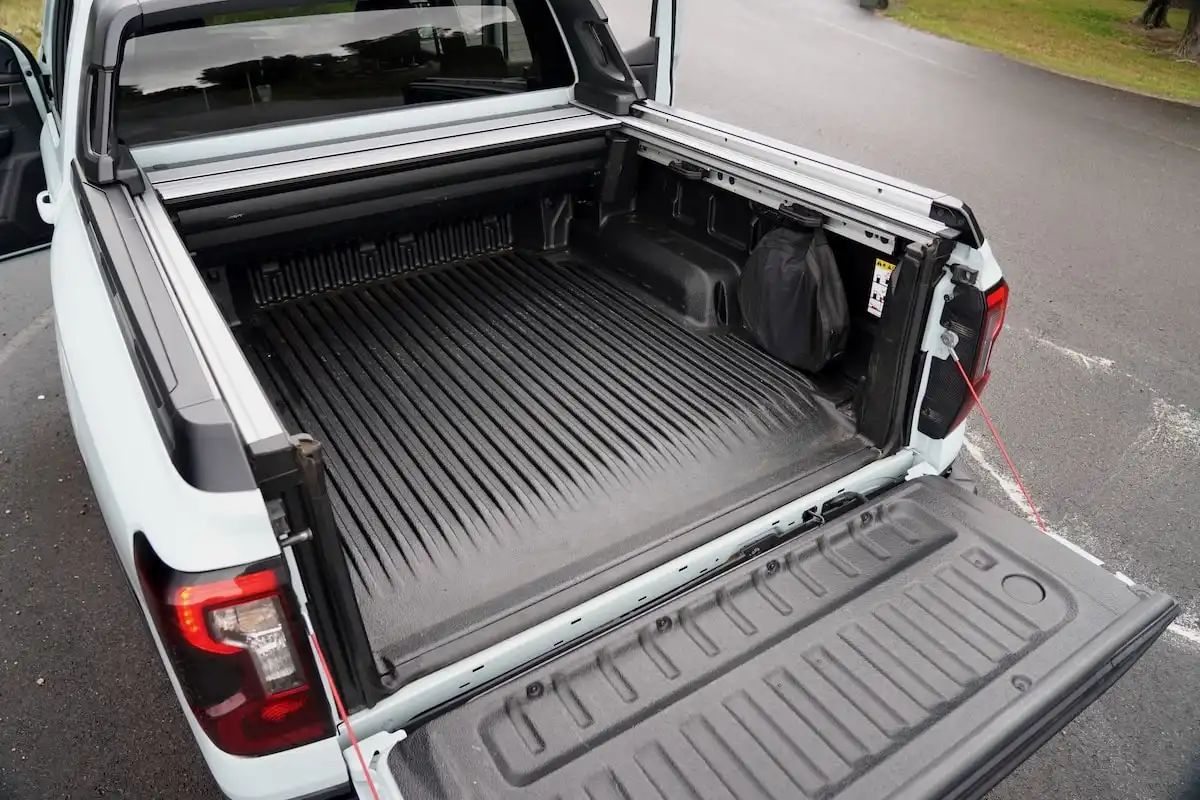
There’s no shortage of tie-down points in the tray, though the headline act back here is Ford's onboard power system, which is a key selling point of the PHEV package overall.
With two vehicle-to-load (V2L) power outlets, each capable of pushing out 3.45kW of juice, the Ranger PHEV is effectively a power plant on wheels that can power some particularly energy-intensive tools while you're out on an isolated job site or keep you powered while camping.
-
Tray Length: 1,638mm
-
Tray Width: 1,584mm
-
Tray Width Between Wheel Arches: 1,233mm
-
Tray Depth: 498mm
Is it Safe?
Ford has thrown in a tonne of safety equipment to sweeten the deal for buyers.
As standard, Ranger PHEV buyers pick up AEB with junction assist and vehicle, pedestrian and cyclist detection, blind-spot monitoring, rear cross traffic alerts, lane-keep assistance with road edge detection, lane departure alerts and a rear-view camera with rear-mounted parking sensors.
Stepping up to the XLT PHEV adds blind-spot monitoring including trailer coverage, traffic sign detection and tyre pressure monitoring, while the Sport PHEV picks up lane-centring and an adaptive cruise control system that includes stop & go.
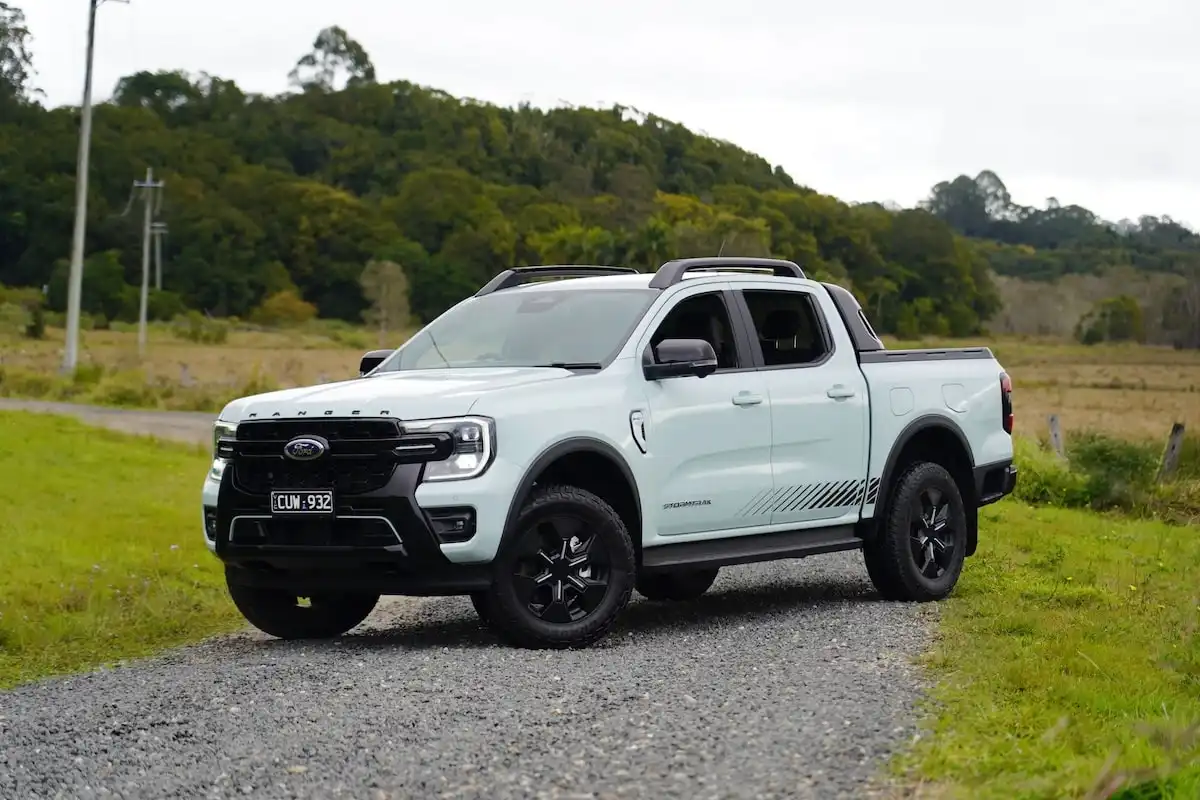
The Ranger Wildtrak PHEV picks up a surround-view monitor and Ford's Pro trailer back-up assist.
The Ford Ranger PHEV lineup remains unrated by ANCAP, though the regular Ranger lineup has picked up a five-star safety rating from testing in 2022.
For reference, the Ranger scored the following marks, though to reiterate, this ANCAP safety rating does not apply to plug-in hybrid nor Raptor variants.
-
Adult Occupant Protection: 84%
-
Child Occupant Protection: 93%
-
Vulnerable Road User Protection: 74%
-
Safety Assist: 83%
What Warranty does the Ford Ranger PHEV Come With?
Ford offers the Ranger PHEV range with a five-year/unlimited kilometre vehicle warranty alongside a separate eight-year/160,000 kilometre warranty for the battery and high-voltage components.
Buyers also pick up 12 months of roadside assistance from the date of purchase, extending out to seven years if you keep it serviced within the network.
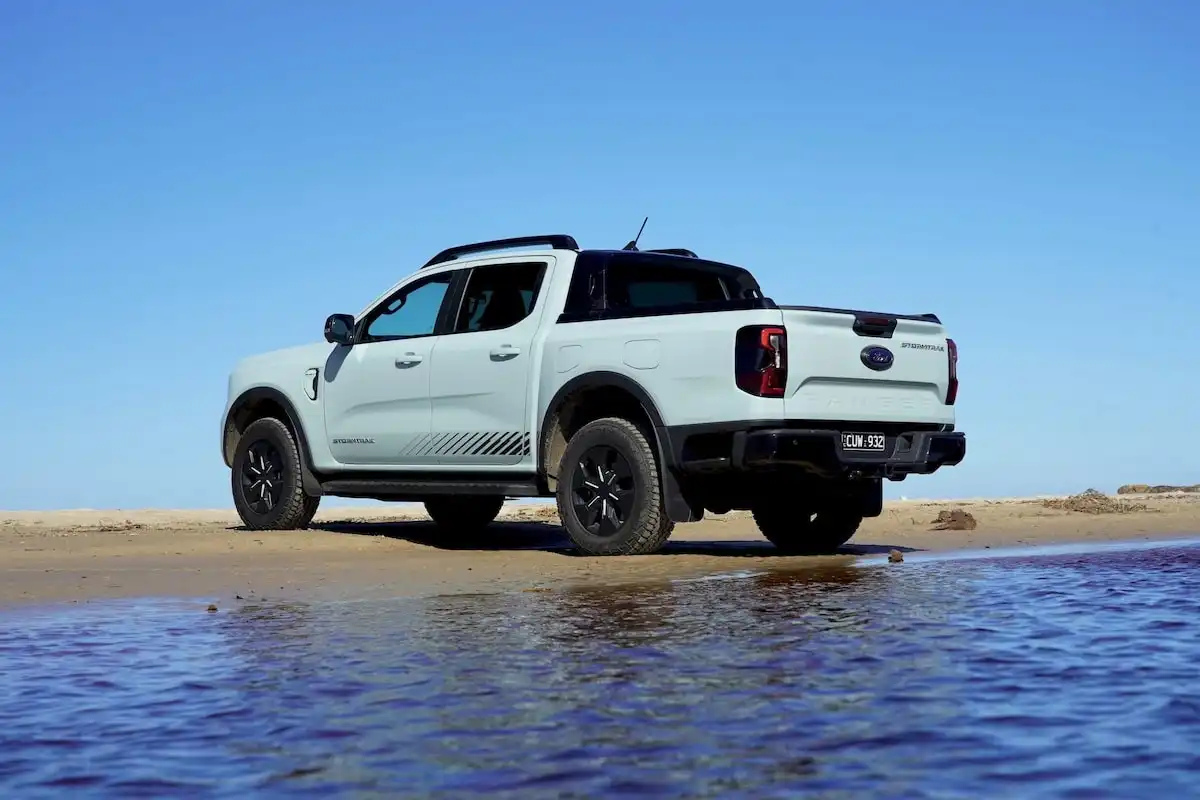
Ford offers five years' worth of capped-price servicing for the Ranger PHEV range, which is capped at $399 per visit.
This means that servicing costs for the Ranger PHEV over five years sit at a very reasonable $1,995 in total.
Service intervals for the Ranger PHEV lineup stand at 12 months or 15,000 kilometres, whichever elapses first.
Our Verdict: Is the Ford Ranger PHEV Stormtrak Worth it?
Ford's plug-in hybrid version of the Ranger is a compelling offering, though its allure is lessened in this extremely pricey Stormtrak version.
As a complete package, we think Ford has done a great job giving the Ranger a brand-new beating heart without any major sacrifices to the most fundamental strengths and, indeed, selling points of the platform.
Is it the best of the up-and-coming PHEV ute segment?
Well, it’s got its own virtues, but it doesn't stand up as an outright winner.
While the battery pack and subsequent range are smaller than its direct rivals, this allows the Ranger to offer more payload potential, especially in more affordable grades.
It's also hands-down the most capable off-roader in the segment. We can confidently say it munches both the Shark 6 and Cannon Alpha for breakfast when put to the task of tearing up a rough trail.
In the same breath, however, it's considerably more expensive than those rivals and offers buyers looking for maximum efficiency or EV range less overall potential.
There’s also the steep pricing, which means we can’t help but point out the Stormtrak's comparatively weak value proposition when you compare it to other PHEV variants in the Ranger lineup.
We think the Ranger PHEV Sport strikes a very healthy balance of equipment without breaking the budget, while the PHEV Wildtrak comes extremely well-equipped, while offering buyers a $7,000 discount over this snazzy Stormtrak version.

Don't forget that our team of car-buying experts can help you save thousands on your next purchase - reach out today.
Five Ford Ranger PHEV Stormtrak Specs You Need to Know
-
2.3-litre turbocharged petrol + electric motor produces 207kW/697Nm
-
49km electric range from 11.8kWh NMC battery pack
-
2.9L per 100km fuel economy, 18.7kWh/100km energy efficiency
-
3,500kg braked towing capacity
-
805kg payload figures
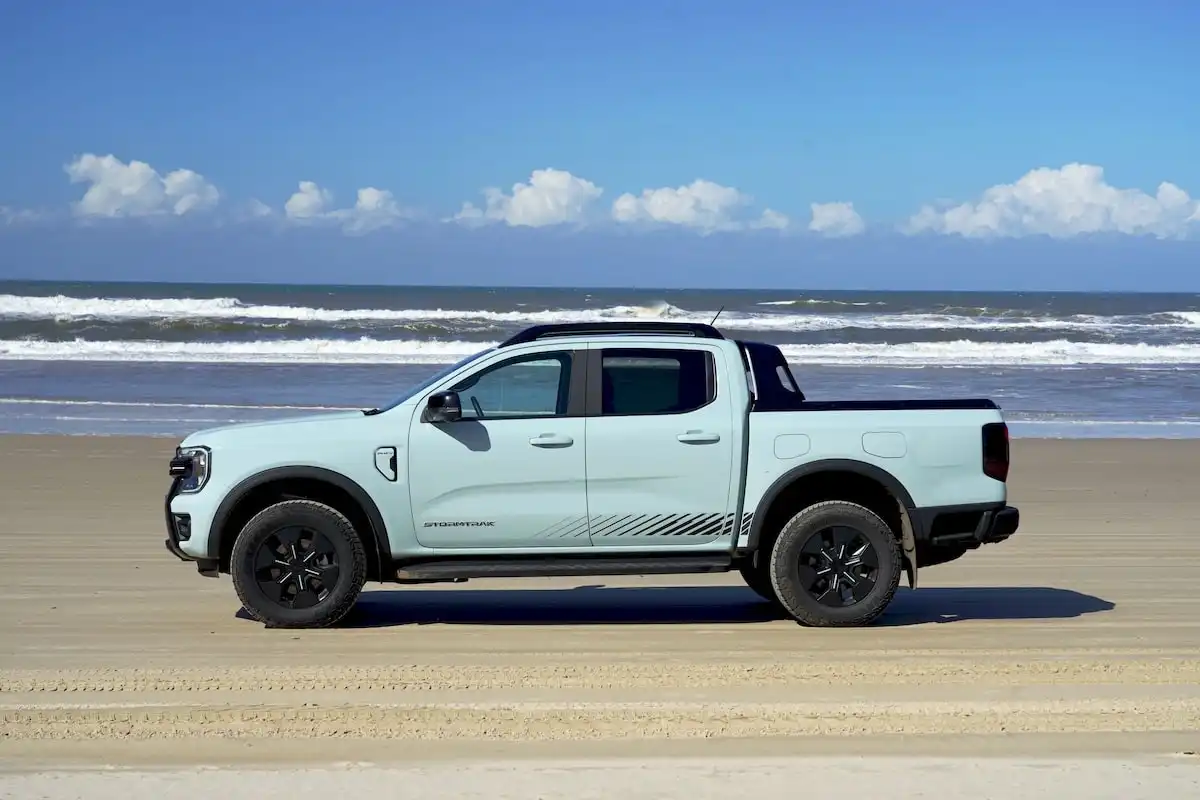
Get in touch with one of our Car Buying Specialists today.
Request a quote